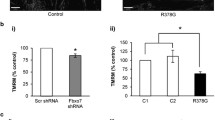Abstract
In the present study mitochondrial respiratory function of fibroblasts from a patient affected by early-onset Parkinsonism carrying the homozygous W437X nonsense mutation in the PINK1 gene has been thoroughly characterized. When compared with normal fibroblasts, the patient’s fibroblast mitochondria exhibited a lower respiratory activity and a decreased respiratory control ratio with cellular ATP supply relying mainly on enhanced glycolytic production. The quantity, specific activity and subunit pattern of the oxidative phosphorylation complexes were normal. However, a significant decrease of the cellular cytochrome c content was observed and this correlated with a reduced cytochrome c oxidase in situ-activity. Measurement of ROS revealed in mitochondria of the patient’s fibroblasts enhanced O •−2 and H2O2 production abrogated by inhibition of complex I. No change in the glutathione-based redox buffering was, however, observed.






Similar content being viewed by others
References
Lang AE, Lozano AM (1998) Parkinson’s disease. First of two parts. N Engl J Med 339:1044–1053
Farrer MJ (2006) Genetics of Parkinson disease: paradigm shifts and future prospects. Nat Rev Genet 7:306–318
Dekker MCJ, Bonifati V, van Duijn CM (2003) Parkinson’s disease: piecing together a genetic jigsaw. Brain 126:1722–1733
Gasser T (2005) Genetics of Parkinson’s disease. Curr Opin Neurol 18:363–369
Valente EM et al (2004) Hereditary early-onset Parkinson’s disease caused by mutations in PINK1. Science 304:1158–1160
Valente EM, Salvi S, Ialongo T, Marongiu R, Elia AE, Caputo V, Romito L, Albanese A, Dallapiccola B, Bentivoglio AR (2004) PINK1 mutations are associated with sporadic early-onset parkinsonism. Ann Neurol 56:336–441
Lücking CB, Dürr A, Bonifati V, Vaughan J, De Michele G, Gasser T, Harhangi BS, Meco G, Denèfle P, Wood NW, Agid Y, Brice A, French Parkinson’s Disease Genetics Study Group; European Consortium on Genetic Susceptibility in Parkinson’s Disease (2000) Association between early-onset Parkinson’s disease and mutations in the Parkin gene. N Engl J Med 342:1560–1567
Bonifati V et al (2005) Early-onset parkinsonism associated with PINK1 mutations: frequency, genotypes, and phenotypes. Neurology 65:87–95
Hedrich K, Hagenah J, Djarmati A, Hiller A, Lohnau T, Lasek K, Grünewald A, Hilker R, Steinlechner S, Boston H, Kock N, Schneider-Gold C, Kress W, Siebner H, Binkofski F, Lencer R, Münchau A, Klein C (2006) Clinical spectrum of homozygous and heterozygous PINK1 mutations in a large German family with Parkinson disease: role of a single hit? Arch Neurol 63:833–838
Gandhi S, Muqit MM, Stanyer L, Healy DG, Abou-Sleiman PM, Hargreaves I, Heales S, Ganguly M, Parsons L, Lees AJ, Latchman DS, Holton JL, Wood NW, Revesz T (2006) PINK1 protein in normal human brain and Parkinson’s disease. Brain 129:1720–1731
Petit A, Kawarai T, Paitel E, Sanjo N, Maj M, Scheid M, Chen F, Gu Y, Hasegawa H, Salehi-Rad S, Wang L, Rogaeva E, Fraser P, Robinson B, St George-Hyslop P, Tandon A (2005) Wild-type PINK1 prevents basal and induced neuronal apoptosis, a protective effect abrogated by Parkinson disease-related mutations. J Biol Chem 280:34025–34032
Pridgeon JW, Olzmann JA, Chin LS, Li L (2007) PINK1 protects against oxidative stress by phosphorylating mitochondrial chaperone TRAP1. PLoS Biol 5:e172
Criscuolo C, Volpe G, De Rosa A, Varrone A, Marongiu R, Mancini P, Salvatore E, Dallapiccola B, Filla A, Valente EM, De Michele G (2006) PINK1 homozygous W437X mutation in a patient with apparent dominant transmission of parkinsonism. Mov Disord 21:1265–1267
Marongiu R, Brancati F, Antonini A, Ialongo T, Ceccarini C, Scarciolla O, Capalbo A, Benti R, Pezzoli G, Dallapiccola B, Goldwurm S, Valente EM (2007) Whole gene deletion and splicing mutations expand the PINK1 genotypic spectrum. Hum Mutat 28:98
Sim CH, Lio DS, Mok SS, Masters CL, Hill AF, Culvenor JG, Cheng HC (2006) C-terminal truncation and Parkinson’s disease-associated mutations down-regulate the protein serine/threonine kinase activity of PTEN-induced kinase-1. Hum Mol Genet 15:3251–3262
Piccoli C, Scacco S, Bellomo F, Signorile A, Iuso A, Boffoli D, Scrima R, Capitanio N, Papa S (2006) cAMP controls oxygen metabolism in mammalian cells. FEBS Lett 580:4539–4543
Rossignol R, Gilkerson R, Aggeler R, Yamagata K, Remington SJ, Capaldi RA (2004) Energy substrate modulates mitochondrial structure and oxidative capacity in cancer cells. Cancer Res 64:985–993
Gottlieb RA, Adachi S (2000) Nitrogen cavitation for cell disruption to obtain mitochondria from cultured cells. Methods Enzymol 322:213–221
Boffoli D, Scacco SC, Vergari R, Persio MT, Solarino G, Laforgia R, Papa S (1996) Ageing is associated in females with a decline in the content and activity on the b-c1 complex in skeletal muscle mitochondria. Biochim Biophys Acta 1315:66–72
Papa S, Guerrieri F, Izzo G (1986) Cooperative proton-transfer reactions in the respiratory chain: redox bohr effects. Methods Enzymol 126:331–343
Scacco S, Vergari R, Scarpulla RC, Technikova-Dobrova Z, Sardanelli A, Lambo R, Lorusso V, Papa S (2000) cAMP-dependent phosphorylation of the nuclear encoded 18-kDa (IP) subunit of respiratory complex I and activation of the complex in serum-starved mouse fibroblast cultures. J Biol Chem 275:17578–17582
Wheeler CR, Salzman JA, Elsayed NM, Omaye ST, Korte DW (1990) Automated assays for superoxide dismutase, catalase, glutathione peroxidase, and glutathione reductase activity. Anal Biochem 184:193–199
Yang NC, Ho WM, Chen YH, Hu ML (2002) A convenient one-step extraction of cellular ATP using boiling water for the luciferin–luciferase assay of ATP. Anal Biochem 306:323–327
Bellomo F, Piccoli C, Cocco T, Scacco S, Papa F, Gaballo A, Boffoli D, Signorile A, D’Aprile A, Scrima R, Sardanelli AM, Capitanio N, Papa S (2006) Regulation by the cAMP cascade of oxygen free radical balance in Mammalian cell. Antioxid Redox Sign 8:495–502
Iuso A, Scacco S, Piccoli C, Bellomo F, Petruzzella V, Trentadue R, Minuto M, Ripoli M, Capitanio N, Zeviani M, Papa S (2006) Dysfunctions of cellular oxidative metabolism in patients with mutations in the NDUFS1 and NDUFS4 genes of complex I. J Biol Chem 281:10374–10380
Johnson DK, Schillinger KJ, Kwait DM, Hughes CV, McNamara EJ, Ishmael F, O’Donnell RW, Chang MM, Hogg MG, Dordick JS, Santhanam L, Ziegler LM, Holland JA (2002) Inhibition of NADPH oxidase activation in endothelial cells by ortho-methoxy-substituted catechols. Endothelium 9:191–203
Majander A, Finel M, Wikstrom M (1994) Diphenyleneiodonium inhibits reduction of iron–sulfur clusters in the mitochondrial NADH-ubiquinone oxidoreductase (Complex I). J Biol Chem 269:21037–21042
Chen Q, Lesnefsky EJ (2006) Depletion of cardiolipin and cytochrome c during ischemia increases hydrogen peroxide production from the electron transport chain. Free Radic Biol Med 40:976–982
Lin MT, Beal F (2006) Mitochondrial dysfunction and oxidative stress in neurodegenerative diseases. Nature 443:787–795
Hoepken HH, Gispert S, Morales B, Wingerter O, Del Turco D, Mülsch A, Nussbaum RL, Müller K, Dröse S, Brandt U, Deller T, Wirth B, Kudin AP, Kunz WS, Auburger G (2007) Mitochondrial dysfunction, peroxidation damage and changes in glutathione metabolism in PARK6. Neurobiol Dis 25:401–411
Wang HL, Chou AH, Yeh TH, Li AH, Chen YL, Kuo YL, Tsai SR, Yu ST (2007) PINK1 mutants associated with recessive Parkinson’s disease are defective in inhibiting mitochondrial release of cytochrome c. Neurobiol Dis 28:216–226
Burke WJ (2004) Neurotoxicity of MAO metabolites of catecholamine neurotransmitters: role in neurodegenerative diseases. Neurotoxicology 25:101–115
Abou-Sleiman PM, Muqit MM, Wood NW (2006) Expanding insights of mitochondrial dysfunction in Parkinson’s disease. Nat Rev Neurosci 7:207–219
Acknowledgments
This work was supported by Research Funds 2006 University of Bari, University of Foggia; Foundation of Cassa di Risparmio di Puglia; The National Project on “Molecular Mechanisms, Physiology and Pathology of Membrane Bioenergetics Systems”, MIUR 2005, Italy.
Author information
Authors and Affiliations
Corresponding author
Additional information
Special issue article in honor of Anna Maria Giuffrida-Stella.
Rights and permissions
About this article
Cite this article
Piccoli, C., Sardanelli, A., Scrima, R. et al. Mitochondrial Respiratory Dysfunction in Familiar Parkinsonism Associated with PINK1 Mutation. Neurochem Res 33, 2565–2574 (2008). https://doi.org/10.1007/s11064-008-9729-2
Received:
Accepted:
Published:
Issue Date:
DOI: https://doi.org/10.1007/s11064-008-9729-2




